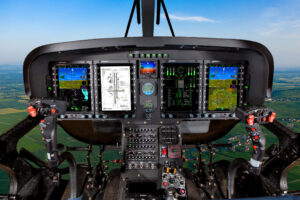
Genesys Blog
The Benefits Of SVS & HITS For Pilots
In the ever-evolving world of avionics, technology continues to play a pivotal role in enhancing safety, efficiency, and overall flight experience. Among these, 3D Synthetic Vision System (SVS) and Highway-In-The-Sky (HITS) imagery are two technological advancements that have garnered significant attention in modern PFD/MFD glass cockpit environments.

Genesys Glass Cockpit Example
Genesys Aerosystems’ legacy with SVS and HITS is well known, being the first to certify 3D SVS terrain, obstacles, and traffic display on a PFD and was the first to certify them for all classes of aircraft (Part 23, Part 25, Part 27, and Part 29). Genesys was also the first to certify a conformal runway depiction and conformal traffic depiction on a PFD as part of the HITS display.

HITS Example

SVS Example
These innovative systems offer a multitude of benefits to pilots, transforming the way they navigate and manage flights. Below, we delve into the various advantages of SVS and HITS, highlighting their impact on modern aviation.
Enhanced Situational Awareness
One of the most significant benefits of SVS and HITS displays are the dramatic improvement in situational awareness. Pilots are provided with a clear 3D representation of the terrain, obstacles, flight path, and other critical flight information, regardless of the external visibility conditions. This enhanced situational awareness is crucial for several reasons:
- Terrain Awareness: SVS provides a detailed, real-time depiction of the terrain, helping pilots to avoid potential hazards such as mountains, hills, and other geographical features.
- Obstacle Avoidance: The system highlights man-made obstacles like towers, buildings, and other structures, ensuring pilots can navigate safely around them.
- Runway Visualization: During approach and landing, SVS offers a clear view of the runway, aiding in smoother and safer landings, especially in poor visibility conditions.
- Flight Path Awareness: One of the key advantages of HITS is its ability to simplify complex flight information into an intuitive and easy-to-understand format. By projecting a virtual “highway” in the sky, pilots are presented with a clear path to follow, reducing cognitive workload and allowing for more efficient decision-making. This visual guidance system helps pilots maintain precise navigation, especially during critical phases of flight such as approach and landing.

SVS & HITS On PFD Display
Improved Safety
Safety is paramount in aviation, and SVS/HITS significantly contribute to this aspect. By providing a comprehensive visual representation of the environment, SVS/HITS helps in mitigating various risks associated with flying:
- Reduced Risk of Controlled Flight Into Terrain (CFIT): CFIT accidents occur when an airworthy aircraft is inadvertently flown into the ground, water, or an obstacle. SVS/HITS helps in preventing such accidents by providing continuous terrain awareness and flight path awareness.
- Enhanced Night and IMC Operations: Flying at night or in Instrument Meteorological Conditions (IMC) can be challenging. SVS/HITS ensures that pilots have a clear “daytime like” view of their surroundings and flight path in all weather conditions and time of day, reducing the risks associated with these conditions.
- Emergency Situations: In the event of an emergency, such as engine failure, SVS/HITS can assist pilots in identifying suitable landing sites and navigating safely to them.
- Enhanced Safety: By presenting a visual representation of the flight path, HITS helps pilots maintain precise navigation, especially during critical phases of flight. This reduces the risk of runway incursions, airspace violations, and other potential safety hazards.
Increased Efficiency
Efficiency in flight operations is another area where SVS/HITS excels. By providing accurate and real-time information, SVS/HITS aids pilots in making informed decisions that enhance overall flight efficiency:
- Optimized Flight Paths: With a clear view of the terrain and obstacles, pilots can choose the most efficient flight paths, reducing fuel consumption and flight time.
- Reduced Workload: SVS/HITS simplifies the process of monitoring and interpreting flight data, allowing pilots to focus on other critical tasks and reducing their overall workload.
- Enhanced Navigation: HITS aids in ILS precision level navigation, ensuring that flights adhere to planned routes and minimizing deviations.
Increased Pilot Confidence
The confidence of a pilot is crucial for the successful operation of an aircraft. SVS/HITS plays a significant role in boosting pilot confidence by providing reliable and intuitive information:
- Intuitive Interface: SVS/HITS feature intuitive and user-friendly interfaces, making it easier for pilots to interpret and act on the information provided.
- Consistent Information: Regardless of external conditions, SVS/HITS offers consistent and reliable data, ensuring that pilots can trust the information they receive.
- Training and Familiarization: The use of SVS/HITS in training programs helps pilots become familiar with the system, further enhancing their confidence in using it during actual flights.
Conclusion
SVS and HITS represents significant leaps forward in aviation technology, offering numerous benefits that enhance safety, efficiency, and overall flight experience. By providing enhanced situational awareness, improving safety, increasing efficiency, and boosting pilot confidence, SVS/HITS are an invaluable tool for modern pilots. As technology continues to advance, the integration of systems like SVS and HITS will undoubtedly play a crucial role in shaping the future of aviation, making the skies safer and more navigable for all.
About Genesys Aerosystems, a Moog Inc. Company
Genesys Aerosystems is a leading provider of integrated avionics systems for military and civil customers. Genesys Aerosystems’ avionics systems are offered individually and integrated to provide an entire cockpit solution. Its synthetic vision Electronic Flight Instrument System (EFIS) revolutionized safety in low-level flight operations for both fixed-wing and helicopter aircraft makes and models. Genesys Aerosystems’ VFR and IFR approved autopilot solutions are certified and available on many fixed-wing and helicopter aircraft makes and models. For more information, visit www.genesys-aerosystems.com.
About Moog Inc.
Moog is a worldwide designer, manufacturer, and systems integrator of high-performance precision motion and fluid controls and control systems. Moog’s high-performance systems control military and commercial aircraft, satellites, and space vehicles, launch vehicles, defense systems, missiles, automated industrial machinery, marine, and medical equipment. Additional information about the Company can be found at www.moog.com.